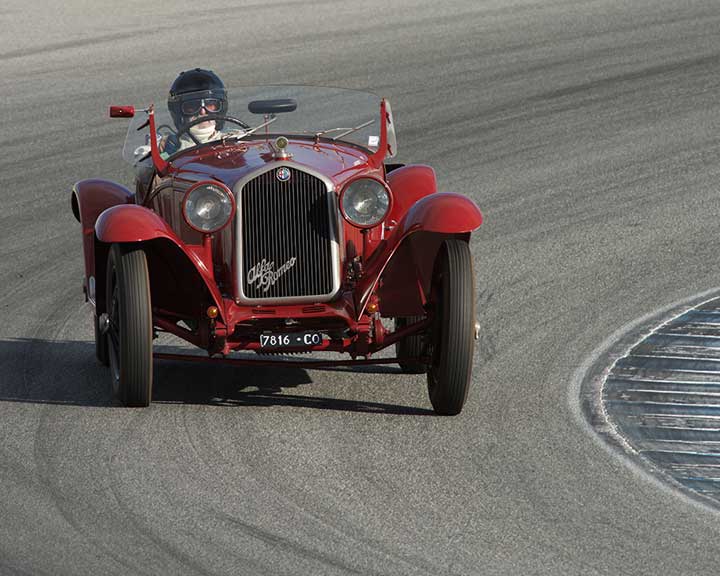1933 Alfa Romeo 6C 1750

The descriptions of the Classic Cars in the Directory were partly generated or supplemented with the help of artificial intelligence (AI). The content may occasionally not always be entirely accurate or factually correct despite careful checking.
The Alfa Romeo 6C 1750 was produced by the Italian car manufacturer between 1929 and 1933. The 1933 model is considered to be the pinnacle of Alfa Romeo’s achievements during this era. Renowned for its sleek and sophisticated design, the Alfa Romeo 6C 1750 quickly became a status symbol for car enthusiasts and racing drivers alike. The 1933 model was fitted with a powerful 6-cylinder engine, which was capable of producing 85 horsepower. This powerful engine, combined with the Alfa Romeo’s lightweight chassis, made this car the perfect choice for racing and high-speed endurance drives.
The 6C 1750 1933 model was the eighth and final version of the 6C 1750 series. The car featured a 1.8-liter inline six-cylinder engine, which provided ample power to the rear wheels. This was a significant improvement compared to the previous 6C models, as the engine was now equipped with a supercharger. The supercharger provided a boost to the engine, enabling it to produce more power and torque.
One of the most striking features of the Alfa Romeo 6C 1750 1933 model is its sleek bodywork. The car had a long, low profile which made it aerodynamic and aesthetically pleasing. The bodywork was constructed from lightweight aluminum, which made it quick and nimble on the road. The car featured a distinctive grille, which was flanked by two large headlamps. The car’s curves and angles gave it an elegant appearance, which oozed sophistication and style.
The Alfa Romeo 6C 1750 1933 model featured an independent suspension system in the front, which consisted of a wishbone setup with hydraulic shock absorbers. The rear suspension system was a live axle with semi-elliptical leaf springs and hydraulic shock absorbers. This system provided a smooth and stable ride and exceptional handling, ideal for racing on the track.
The car had a top speed of approximately 95mph, which was impressive considering the time period. The engine was mated to a four-speed manual transmission, which allowed drivers to shift gears with ease. The Alfa Romeo 6C 1750 was known for its excellent handling, and the 1933 model was no exception. The car featured a four-wheel hydraulic brake system, which was a significant improvement compared to the earlier drum brake models.
In conclusion, the Alfa Romeo 6C 1750 1933 model was a masterpiece of engineering and design. The car’s sleek and aerodynamic bodywork, powerful engine, and advanced suspension and braking systems made it a force to be reckoned with on the racetrack. The Alfa Romeo 6C 1750 1933 model is considered a true classic, and for good reason – it remains one of the finest examples of Italian engineering and design, even today.
Milestones
- Introduction of the Alfa Romeo 6C 1750 in 1929 - 1930 - Alfa Romeo 6C 1750 wins the Mille Miglia endurance race - 1930 - Alfa Romeo 6C 1750 wins the Targa Florio endurance race - 1931 - Introduction of the Alfa Romeo 6C 1750 Gran Sport model - 1931 - Alfa Romeo 6C 1750 wins the French Grand Prix - 1933 - Introduction of the Alfa Romeo 6C 1750 Super Sport model - 1933 - Alfa Romeo 6C 1750 Super Sport wins the 24 Hours of Le Mans endurance race - 1934 - Alfa Romeo 6C 1750 Super Sport wins the Mille Miglia endurance race - 1935 - End of production of the Alfa Romeo 6C 1750.Technical
- Engine displacement: 1,752 cc - Maximum power output: 85 hp at 4,500 rpm - Four-speed manual transmission - Top speed: 123 km/h (76 mph) - Double overhead camshaft (DOHC) engine - Four-wheel drum brakes - Length: 4,180 mm (164.6 in) - Width: 1,570 mm (61.8 in) - Height: 1,520 mm (59.8 in) - Wheelbase: 2,750 mm (108.3 in) - Body style: two-door coupe, convertible or roadster - Weight: 1,090 kg (2,403 lb) - Fuel tank capacity: 70 L (18.5 US gal; 15.4 imp gal) - Suspension: independent front suspension with leaf spring and rear solid axle with leaf springs.